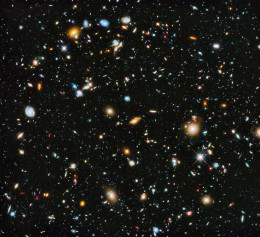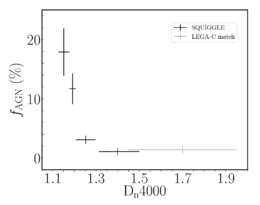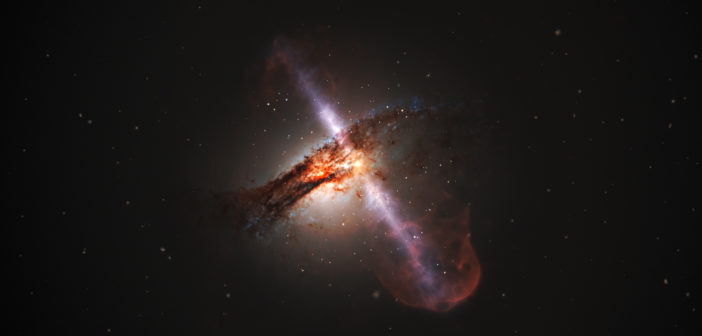Editor’s note: Astrobites is a graduate-student-run organization that digests astrophysical literature for undergraduate students. As part of the partnership between the AAS and astrobites, we occasionally repost astrobites content here at AAS Nova. We hope you enjoy this post from astrobites; the original can be viewed at astrobites.org.
Note: the title of this article has been changed from its original version.
Title: The Role of Active Galactic Nuclei in the Quenching of Massive Galaxies in the SQuIGGLE Survey
Authors: Jenny E. Greene et al.
First Author’s Institution: Princeton University
Status: Published in ApJL
To butcher an apocryphal quote about cars, galaxies can be any colour, as long as it’s red or blue. If you were to plot the magnitude and colour of a large sample of galaxies you would see that they fall into two groups: one is actively star-forming and filled with young blue stars, and the other has long since finished making new stars so is left with only the older, redder populations. Between these two monolithic groups, however, there is an elusive class of galaxies. Post-starburst galaxies (PSBs) are objects that are thought to have had large amounts of star-formation shut off very rapidly in a quenching event. This quick transition means that PSB samples are generally quite small, so the origins of quenching are still quite uncertain. However, studying PSBs is still thought to be the best route to understanding what causes galaxies to transition from blue to red.

Figure 1: This Hubble Ultra-Deep Field image reveals around 10,000 galaxies that are red, blue, and shades in between. [NASA/ESA/H. Teplitz & M. Rafelski (IPAC/Caltech)/A. Koekemoer (STScI)/R. Windhorst (Arizona State University)/Z. Levay (STScI)]
Connecting the Dots with SQuIGGLE
The authors showcase a brand-new galaxy survey dedicated to studying quenching activity at intermediate redshifts. The Studying of Quenching in Intermediate-z Galaxies: Gas, anguLar momentum and Evolution (SQuIGGLE) survey contains thousands of massive galaxies found in SDSS DR14. From this survey they use 1,207 PSBs at redshifts between 0.5 and 0.94. In addition, they construct a separate sample of galaxies in a similar mass and redshift regime from the LEGA-C survey to act as a comparison.
AGNs in this sample are identified in the optical part of the spectrum. This is typically done using the BPT diagnostic, where two optical emission line ratios are compared to distinguish between AGNs and star-formation as the primary source of ionisation. Due to the high redshift of the AGNs in this sample, however, some of the emission lines used in the BPT diagram do not appear in their spectra, rendering one of these ratios unusable. Instead, the authors turn to the mass–excitation diagram, which is based on the BPT diagram but replaces the lost emission line ratio with stellar mass. Enhancement of the remaining BPT ratio, called the excitation axis, can be caused by lower metallicity, but this only occurs in lower-mass galaxies, as they typically host younger stars. Given these are fairly high mass galaxies, we know that their metallicity is higher, so any increase in the excitation axis is due to AGN activity. This means the authors can identify AGNs by looking for enhancement in the excitation axis within these relatively high mass galaxies. Alongside this, they also apply a spectral signal-to-noise threshold to make sure these excitation detections are real.
Do AGN Quench Star Formation?
Taking these criteria together, the authors find a sample of 64 AGNs in the PSB sample, leading to an AGN fraction of about 5%. Only five AGNs were found in the comparison sample, leading to an overall AGN fraction of 1.4%. This reveals that AGNs are more likely to be found in PSBs than in a sample of regular galaxies of similar mass and redshift.

Figure 2: Comparing the AGN fraction as a function of galaxy age for the PSBs (taken from SQuIGGLE) and the normal galaxy sample (taken from LEGA-C). Dn4000 (4,000-angstrom break) describes the age of the galaxy, with a higher Dn4000 corresponding to an older galaxy. [Adapted from Greene et al. 2020]
AGN fractions appear to peak around the time of the quenching event where AGN-driven winds could force gas out of the host galaxy. In doing this, the AGN also removes sources of future fuel, causing the large drop in AGN fraction as the galaxies get older. Such a strong correlation between AGN fraction and the galaxy’s age suggests AGN activity could play a role in quenching galaxies. Whilst this correlation is compelling, it isn’t definitive. This makes the follow-up work being done by the authors all the more important: they are searching these AGNs for signs of outflows, which, if found, would suggest that star formation really is quenched by AGN-driven winds.
About the author, Keir Birchall:
Keir is a PhD student studying methods to identify AGN in various populations of galaxies to see what affects their incidence. When not doing science, he can be found behind the lens of a film camera or listening to the strangest music possible.


1 Comment
Pingback: The Link Between Black Holes and Their Galaxies